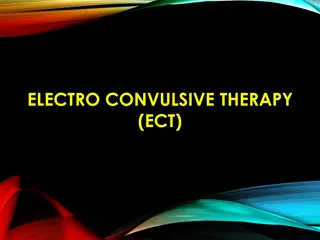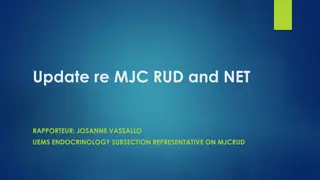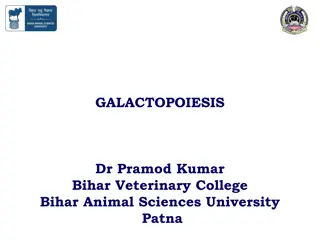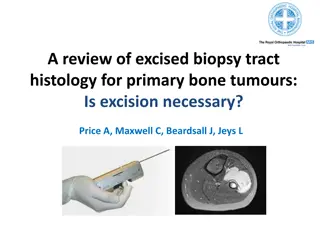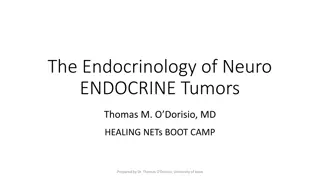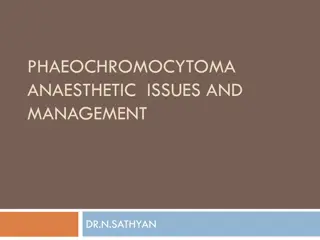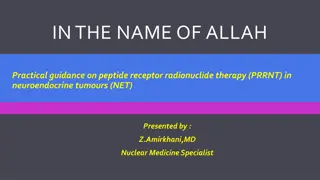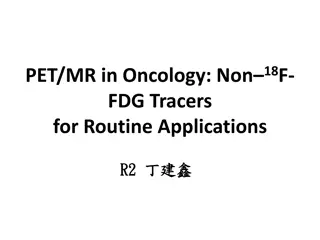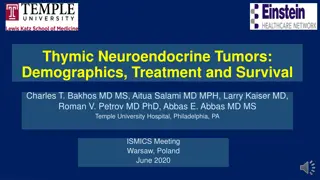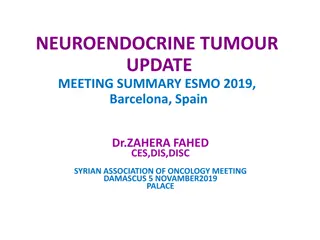Understanding Electroconvulsive Therapy (ECT) for Psychiatric Treatment
Electroconvulsive Therapy (ECT), also known as electroshock, is a psychiatric treatment that induces seizures in anesthetized patients for therapeutic purposes. ECT has a controversial history but is well-established in the medical field. Introduced in 1938, ECT has replaced older treatments like in
1 views • 17 slides
Understanding Laryngeal Tumours: Types, Classification, and Pathology
Laryngeal tumours can be benign or malignant, with different types such as papilloma, chondroma, paraganglioma, and squamous cell carcinoma. These tumours present with various symptoms and may spread through direct, lymphatic, or hematogenous routes. Risk factors include tobacco smoking, alcohol con
0 views • 24 slides
Overview of Bladder Tumours: Causes, Symptoms, and Diagnosis
Bladder tumours, particularly Transitional Cell Carcinoma (TCC), are the second most common cancer in the genitourinary system. Mainly caused by factors like cigarette smoking, industrial toxins, and genetic events, bladder cancer presents with symptoms such as hematuria and irritative voiding sympt
0 views • 26 slides
Updates on European Training Requirements for Rare Diseases and Neuroendocrine Neoplasia Medicine
Comprehensive updates on European training requirements for rare diseases, rare adult solid cancers, and neuroendocrine neoplasia medicine. Initiatives include syllabi, competencies, and collaborations with international networks for advancements in the field.
0 views • 6 slides
Understanding Galactopoiesis and Milk Ejection in Veterinary Science
Galactopoiesis is the process of maintaining lactation in animals, involving hormones like prolactin, GH, cortisol, PTH, insulin, and oxytocin. This process also includes the role of progesterone, estrogen, and other hormones in milk production and release. Milk ejection, facilitated by oxytocin, in
0 views • 5 slides
Comprehensive Guidelines for Medullary Thyroid Carcinoma Management
Medullary thyroid carcinoma (MTC) is a rare neuroendocrine tumor that requires specialized management. This comprehensive guide covers the clinical presentation, diagnosis, genetic aspects, and detailed management strategies for MTC, including surgical options, follow-up evaluation, and systemic the
0 views • 123 slides
Organoid Models for Neuroendocrine Cell Growth and Tumorigenesis
Research presented at the ENETS 2020 virtual meeting discussed the generation of organoids from lung, intestinal, and pancreatic neuroendocrine neoplasms (NENs) to study normal neuroendocrine cells and their transformation to NENs. The success rate in generating organoids was higher for lung NENs co
0 views • 20 slides
Excised Biopsy Tract Histology for Primary Bone Tumours: Necessity of Excision Examined
Investigating the necessity of excising biopsy tracts in primary bone tumours, this study analyzed 278 patients over a span of two years. Findings indicated conflicting evidence regarding the risk of malignant seeding in biopsy tracts, with only one patient showing histological evidence of seeding.
0 views • 14 slides
Understanding Neuroendocrine Tumors: Endocrinology Insights
Delve into the complex world of neuroendocrine tumors (NETs) through a detailed presentation prepared by Dr. Thomas O'Dorisio from the University of Iowa. Explore case reports, therapeutic interventions, and the challenges associated with managing these tumors. Gain valuable insights into the functi
0 views • 24 slides
Anesthetic Management of Phaeochromocytoma: Key Issues and Strategies
Phaeochromocytoma, a neuroendocrine tumor of the adrenal medulla, presents unique challenges in anesthesia due to excessive catecholamine secretion. From clinical presentation to familial associations, this condition requires careful diagnosis and management to avoid complications during surgery. Un
0 views • 39 slides
Comprehensive Guide to Peptide Receptor Radionuclide Therapy (PRRNT) in Neuroendocrine Tumours (NET)
Peptide Receptor Radionuclide Therapy (PRRNT) is a targeted approach using radiopharmaceuticals to deliver radiation to neuroendocrine tumors expressing specific receptors. This therapy, involving 90Y-DOTATOC or 177Lu-DOTATATE, has shown promising results in treating NETs with minimal side effects.
0 views • 36 slides
Understanding Opioid Use Disorder and Treatment Options
This presentation delves into the complexities of Opioid Use Disorder (OUD), discussing its impact on the neuroendocrine system, treatment options, including Medications for Opioid Use Disorder (MOUD), and special populations. The objective is to connect endogenous mechanisms to clinical observation
0 views • 52 slides
Advances in Non-18F-FDG Tracers for PET/MR Imaging in Oncology
Explore the emerging role of non-18F-FDG tracers in PET/MR imaging for oncology, focusing on their use in detecting neuroendocrine tumors and prostate cancer. Learn about the potential benefits of these tracers and the challenges they address in tumor localization and staging.
0 views • 35 slides
Thymic Neuroendocrine Tumors: Demographics, Treatment, and Survival Study
This study presents an analysis of thymic neuroendocrine tumors (TNET) focusing on demographics, treatment, and survival outcomes. Conducted as a retrospective cohort study using the NCDB data from 2004 to 2015, the study aimed to examine the characteristics of TNET in terms of demographics, clinica
0 views • 16 slides
Durvalumab Plus Tremelimumab in Advanced Neuroendocrine Neoplasms: The DUNE Trial at ESMO 2020
A multi-cohort phase 2 study presented at ESMO 2020 evaluated the combination of durvalumab and tremelimumab in patients with advanced neuroendocrine neoplasms. The DUNE trial assessed the efficacy of this immunotherapy approach in various neuroendocrine tumor types, emphasizing the potential benefi
0 views • 17 slides
Symptomatic Control of Functioning Pancreatic NET
Pancreatic neuroendocrine tumors (panNETs) can be classified as functioning or non-functioning, with functioning tumors producing active hormones such as insulin, glucagon, gastrin, or VIP. Symptomatic control is crucial for managing these tumors, with diagnoses based on clinical syndromes and hormo
0 views • 19 slides
Advances in Neuroendocrine Tumours: ESMO 2019 Update
Update from the ESMO 2019 meeting in Barcelona focusing on neuroendocrine tumors (NETs). Highlighting challenges in diagnosis and treatment, including limited knowledge and late diagnosis. Discusses different types of NETs, prevalence, approved therapeutic options, and key trials presented at the co
0 views • 20 slides
Overview of Endocrinology: Coordination of Body Functions by Chemical Messengers
The body's functions are coordinated by various chemical messenger systems, including neurotransmitters, endocrine hormones, neuroendocrine hormones, paracrines, autocrines, and cytokines. Endocrine hormones travel through the circulatory system, binding to receptors in cells to regulate metabolism,
0 views • 18 slides
